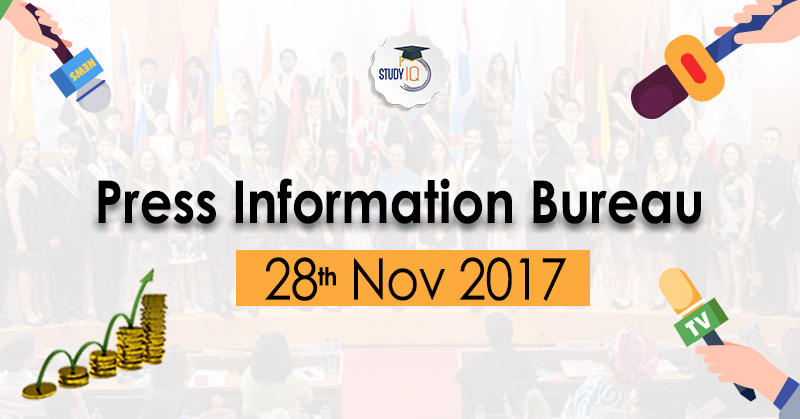Table of Contents
Ministry of Power

- SAUBHGAYA was launched in Manipur today.
- A total of approximately 1.75 lakh households (1.62 lakh rural households and 0.13 lakh urban households) of Manipur to benefit.
- Shri R.K. Singh said that Manipur is the fastest reforming state in Power sector in the country.
- Manipur Government is performing well in terms of power sector in the State.


- 24×7 power supply by March, 2019
- Scheme to ensure last mile connectivity
- Rural Electrification Corporation Limited (REC), a Navaratna CPSE under the Ministry of Power has been appointed as the nodal agency for coordinating the implementation of the scheme.
President’s Secretariat
- The President of India, Shri Ram Nath Kovind, addressed a civic reception hosted for him at Netaji Indoor Stadium, Kolkata today.
- There are few people anywhere in our country who have not been touched by Bengal or by some creation of Bengal.
- Somehow, in some manner, this state has touched every Indian and enriched the life of every Indian.
- Every Indian child has grown up on stories about Bengal or written in Bengal.
- Bengal has a great history – but it is for each one of us to ensure that Bengal also has a great future.
- Bengal was one of the leaders of our freedom movement.
- It must lead this effort for a better India by 2022.
- This state was an early industrial and manufacturing centre in our country.
- Its economy must sing again in this age of digital and robotic technologies.
- Its green fields and hard-working farmers must be equipped with the latest agricultural knowledge to allow them to realise their potential.

 Ministry of Finance
Ministry of Finance
- National Anti-profiteering Authority under GST
- In an immediate follow up action of last week’s Cabinet approval for creation of the posts of Chairman and Technical Members
- Government today issued orders appointing senior IAS officer Shri B.N. Sharma, as the first Chairman of this apex Authority in the rank of Secretary to Government of India.
- Shri B.N. Sharma would be assisted by four senior officials of the rank of Joint Secretary and above, who have been appointed as Technical Members in the Authority.
- Two-year period
- Shri B.N. Sharma has been closely associated with the formulation of GST and its implementation.
Ministry of Road Transport & Highways
- India and United Kingdom will soon sign an MoU in the urban transport sector.
- cooperation in policy planning, technology transfer and institutional organisation
- The MOU will also help in promoting digital transactions and induction of high capacity diesel/electric vehicles in India.
Ministry of Water Resources
- Shri Upendra Prasad Singh, IAS (OR:85) presently holding the charge of Director General, National Mission for Clean Ganga has been appointed as Secretary, Ministry of Water Resources, River Development and Ganga Rejuvenation.
- He will succeed Dr. Amarjit Singh, IAS (GJ:82) who will superannuate on November 30, 2017.
- UN’s Food and Agriculture Organisation says that by 2030, most developing countries will be dependent on imports from developed countries for their food requirements.
- The US and EU are currently supporting agriculture the way they promoted industry in the 1930s.
A.Using the latest technology to maximise output
B.High tariffs to discourage imports
C.Massive subsidies to push exports
- China: outsmarting everyone
- Acquired large tracts of land along the proposed “New Silk Road”
- To grow food and avoid food imports from the US and Oceania.
Where does India stand?
- Doubling farmers’ income in next five years
- Challenges:
- Low productivity
- Low quality awareness
- Rising imports
- 60% of farming is rain dependent: Drought
- 65% of land holdings are less than one acre in size: Mechanisation
- Most farmers cannot buy quality seeds or expertise as they have little money.
- On quality awareness, offering fresh and cheap produce for sale is no more enough.
- One cannot just buy fruits from a mandi and export.
- Food safety and quality regulations of most countries need proof of traceability.
- This means keeping records that prescribed norms have been followed at farm, storage, packaging and transportation levels.
- We account for 4% of global production of but our share in global exports is 1.6%.
- Our share of global output is 30% but of exports is less than 0.4%.
Agricultural
- Agriculture imports have increased six times faster than exports in the past 20 years.
- Large imports in FY2017 are edible oil ($10.9 billion), pulses ($4.2 billion) and apples, kiwi fruits, almonds and cashews ($3 billion).
- These three groups account for 73% of India’s agriculture imports.
- They must be cultivated in India as we have the required soil and climatic conditions.
Solutions
1) Encourage contract farming
- Much of India’s exports and supermarket supplies originate from Contract/Corporate Farming Ventures (CFVs).
- A CFV takes land on lease from a group of farmers and pays an agreed amount and a share of profits to them.
- Or it may supply inputs and expertise to farmers, supervise production and buy the products.
- CFVs apply knowledge and latest techniques and oversee an integrated supply chain.
2) Convert the top 10 agriculture universities into centres for excellence.
- They will make region-specific strategies to raise crop yields, advise on the creation of integrated supply chains, and prepare a plan to promote exports and cut imports.
3) Create 2,000 farmer centres, one in each sub-district.
- Go-to places for all farmers’ needs
- Help farmers sell direct to the consumer.
4) Ensure active monitoring of government schemes
- 35 million farmers who opted for the Pradhan Mantri Fasal Bima Yojna in the last kharif season got their compensation late
- e-NAM: check wrong reporting





















 WhatsApp
WhatsApp